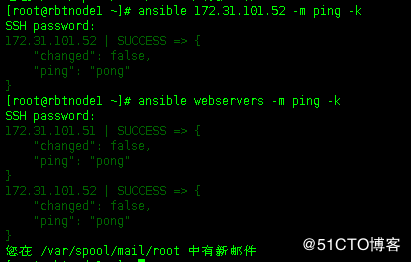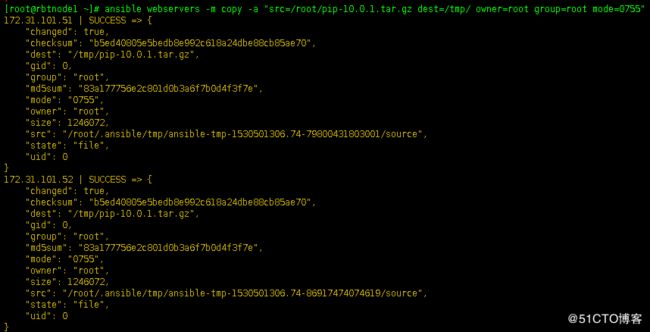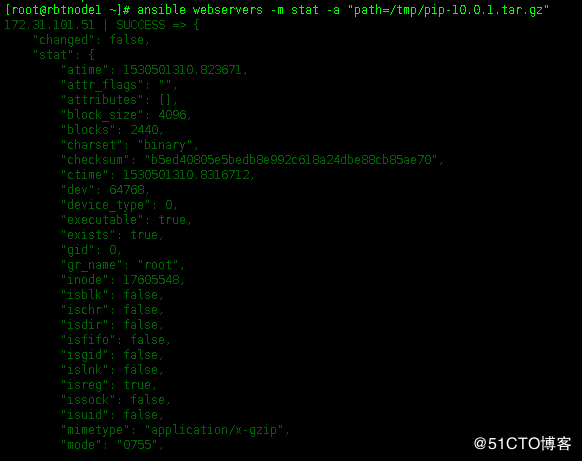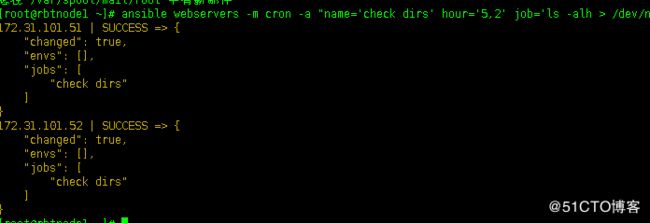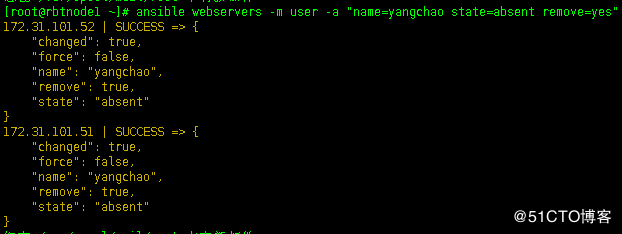一、介绍
Ansible 一种集成 IT 系统的配置管理、应用部署、执行特定任务的开源平台,是 AnsibleWorks 公司名下的项目,该公司由 Cobbler 及 Func 的作者于 2012 年创建成立。
Ansible 基于 Python 语言实现,由 Paramiko 和 PyYAML 两个关键模块构建。
Ansible 特点:
>> 部署简单,只需在主控端部署 Ansible 环境,被控端无需做任何操作。
>> 默认使用 SSH(Secure Shell)协议对设备进行管理。
>> 主从集中化管理。
>> 配置简单、功能强大、扩展性强。
>> 支持 API 及自定义模块,可通过 Python 轻松扩展。
>> 通过 Playbooks 来定制强大的配置、状态管理。
>> 对云计算平台、大数据都有很好的支持。
二、Ansible的安装
Ansible只需在管理端部署环境即可,默认通过yum安装即可。
yum install ansible -y
2.1 Ansible配置及测试
第一步是修改主机与组配置,文件位置/etc/ansible/hosts,格式为ini,添加两台主机ip,同时定义两个IP到webservers组,更新的内容如下:
【/etc/ansible/hosts】 [webservers] #组名 websevers ## alpha.example.org ## beta.example.org 172.31.101.51 #主机1 172.31.101.52 #主机2
通过ping模块测试主机的连通性,分别对单主机及组进行ping操作
ansible 172.31.101.52 -m ping -k #单个主机 ansible webservers -m ping -k #单个组
测试主机连通性如下图所示
由于主控端与被控端主机未配置ssh证书信任,需要执行ansible命令添加-k参数,要求提供root(默认)帐号密码,即提示“SSH password:”时输入
ping模块参数说明
# -i 指定 hosts 文件位置 # -u username 指定 SSH 连接的用户名 # -k 指定远程用户密码 # -f 指定并发数 # -s 如需要 root 权限执行时使用 ( 连接用户不是 root 时 ) # -K -s 时,-K 输入 root 密码
2.2 配置linux主机ssh无密码访问
为了避免Ansible下发指令时输入目标主机密码,可以通过证书签名达到ssh无密码访问。
在主控端创建密钥,执行ssh-keygen -t rsa
[root@rbtnode1 ~]# ssh-keygen -t rsa Generating public/private rsa key pair. Enter file in which to save the key (/root/.ssh/id_rsa): (回车) Enter passphrase (empty for no passphrase): (回车) Enter same passphrase again: (回车) Your identification has been saved in /root/.ssh/id_rsa. Your public key has been saved in /root/.ssh/id_rsa.pub. The key fingerprint is: 8b:8a:91:2e:04:2e:dd:4d:99:c0:e9:f0:5f:f9:85:bb root@rbtnode1 The key's randomart image is: +--[ RSA 2048]----+ | . . | | . + | | + . o . . | |. o + o . . | |o. . + .S. o | |.o... o. .o | |o o . . . | |.. o . E | | .o . | +-----------------+
接下来同步公钥文件id_rsa.pub到目标主机,使用ssh-copy-id公钥拷贝工具,命令格式为/usr/bin/ssh-copy-id [-i[identity-file]][user@]machine
ssh-copy-id -i /root/.ssh//id_rsa.pub [email protected] ssh-copy-id -i /root/.ssh//id_rsa.pub [email protected]
2.3 定义主机与组规则
Ansible通过定义好的主机与组规则(Inventory)对匹配的目标主机进行远程操作,配置规则文件默认是/etc/ansible/hosts,以下为举例说明:
www.abc.com # 定义域名 192.168.1.100 # 定义 IP 192.168.1.150:37268 # 指定端口号 [WebServer] # 定义分组 192.168.1.10 192.168.1.20 192.168.1.30 [DBServer] # 定义多个分组 192.168.1.50 192.168.1.60 Monitor ansible_ssh_port=12378 ansible_ssh_host=192.168.1.200 # 定义别名 # ansible_ssh_host 连接目标主机的地址 # ansible_ssh_port 连接目标主机的端口,默认 22 时无需指定 # ansible_ssh_user 连接目标主机默认用户 # ansible_ssh_pass 连接目标主机默认用户密码 # ansible_ssh_connection 目标主机连接类型,可以是 local 、ssh 或 paramiko # ansible_ssh_private_key_file 连接目标主机的 ssh 私钥 # ansible_*_interpreter 指定采用非 Python 的其他脚本语言,如 Ruby 、Perl 或其他类似 ansible_python_interpreter 解释器 [webservers] # 主机名支持正则描述 www[01:50].example.com [dbservers] db-[a:f].example.com
2.4 目标匹配
目标匹配,格式为ansible
ansible webservers -m service -a "name=httpd state=restarted"
| 规则 | 含义 |
| 192.198.1.2或one.example.com | 匹配目标Ip地址或者主机名,多个ip或主机名使用":"号分隔 |
| webservers | 匹配目标组为webserver,多个组使用":"号分隔 |
| ALL 或 ‘*’ | 匹配目标所有主机 |
| ~(web|db).*\.example\.com 或 192.168.1.* | 支持正则表达式匹配所有主机或ip地址 |
| webservers:!192.168.1.22 | 匹配websevers组且排除192.168.1.22主机ip |
| webservers:&dbservers | 匹配webservers与dbservers两个群组的交集 |
| webservers:!{{excluded}}:&{{required}} | 支持变量匹配的方式 |
2.5查询支持模块及模块说明
ansible-doc -l # 列出 Ansible 支持的模块 ansible-doc ping # 查看该模块帮助信息
三、常用模块及api
3.1远程命令模块
模块包括command、script、shell都可以实现远程shell命令运行。command作为Ansible的默认模块,可以运行远程权限范围内所有的shell命令;script功能是在远程主机上执行主控端存储shell脚本文件,相当于scp+shell组合;shell功能是执行远程主机的shell脚本文件
ansible webservers -m command -a "free -m" ansible webservers -m script -a "/home/test.sh 12 34" ansible webservers -m shell -a "/home/test.sh"
3.2copy模块
实现主控端向目标主机拷贝文件,类似于scp的功能。以下示例实现拷贝/root/pip-10.0.1.tar.gz 文件到webserver组目标主机/tmp/目录下,并更新文件属主及权限
# ansible webservers -m copy -a "src=/root/pip-10.0.1.tar.gz dest=/tmp/ owner=root group=root mode=0755"
3.3 stat模块
获取远程文件的状态信息,包括atime ,ctime ,md5等信息
ansible webservers -m stat -a "path=/tmp/pip-10.0.1.tar.gz"
4.4 get_url模块
实现在远程主机下载指定URL到本地,支持sha256sum文件校验
ansible webservers -m get_url -a "url=http://www.baidu.com dest=/tmp/index.html mode=0440 force=yes"
4.5 yum模块
linux平台软件包管理操作,常见有yum,apt管理方式
ansible webservers -m yum -a "name=wget state=latest
4.6 cron模块
远程主机crontab配置
ansible webservers -m cron -a "name='check dirs' hour='5,2' job='ls -alh > /dev/null'"
在远程主机查看计划任务
4.7 mount模块
远程主机的分区挂载
ansible webservers -m mount -a "name=/mnt/date src=fstype=exts opts=ro state=present"
4.8 service模块
远程主机系统服务管理
ansible webservers -m service -a "name=firewalld state=stopped" ansible webservers -m service -a "name=firewalld state=started" ansible webservers -m service -a "name=firewalld state="restartd" ansible webservers -m service -a "name=firewalld state=reloded"
4.8 user服务模块
远程主机系统用户管理
ansible webservers -m user -a "name=yangchao comment='yangchao'" #增加用户 ansible webservers -m user -a "name=yangchao state=absent remove=yes" #删除用户
关于ansible其他模块及详细用法,请参照
http://www.ansible.com.cn/docs/modules_intro.html
